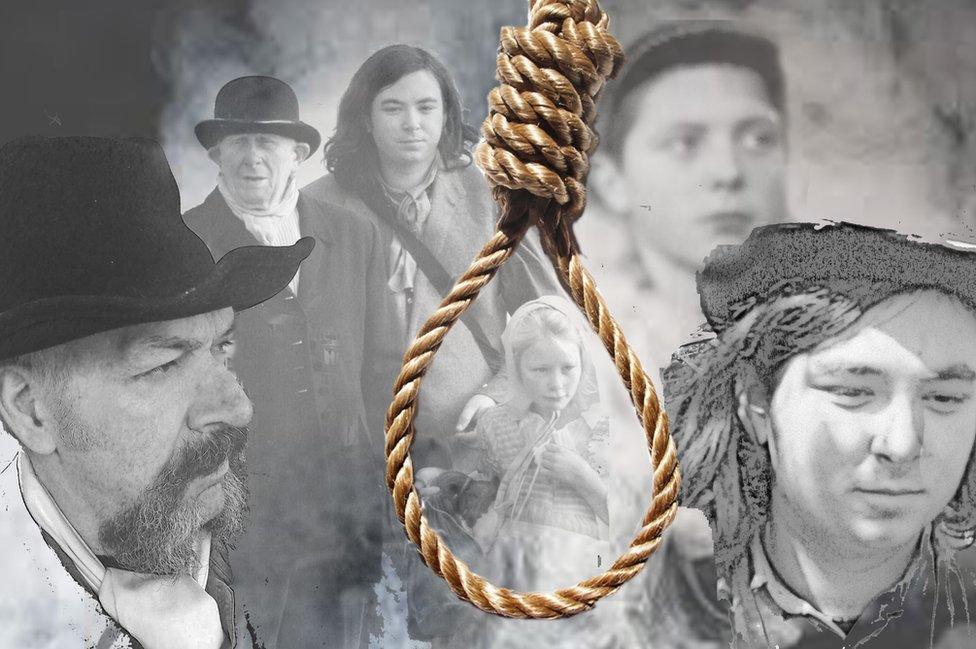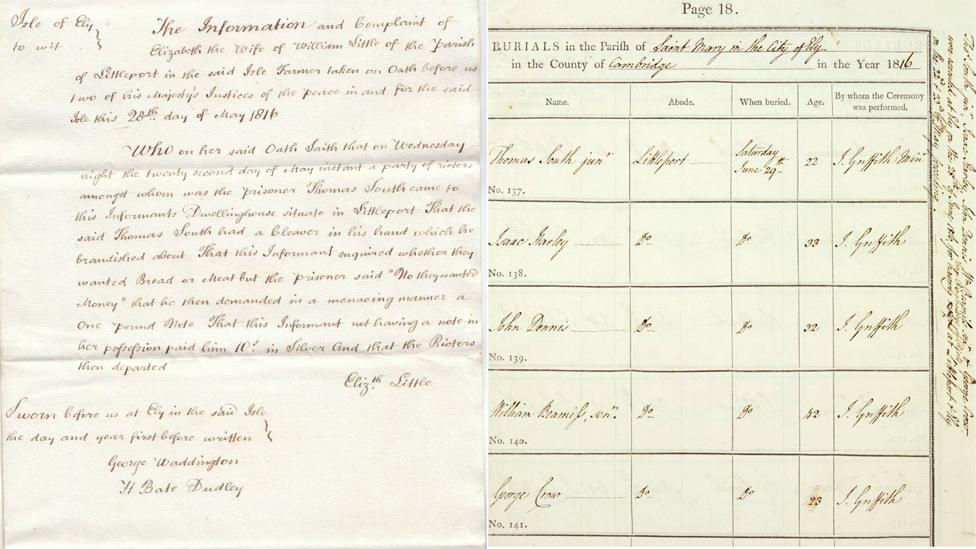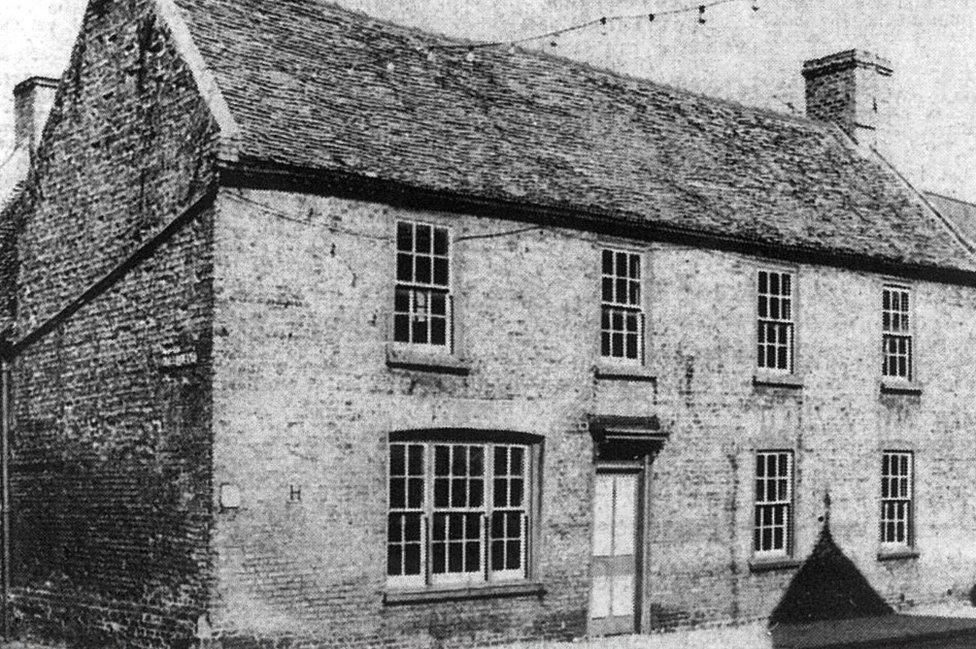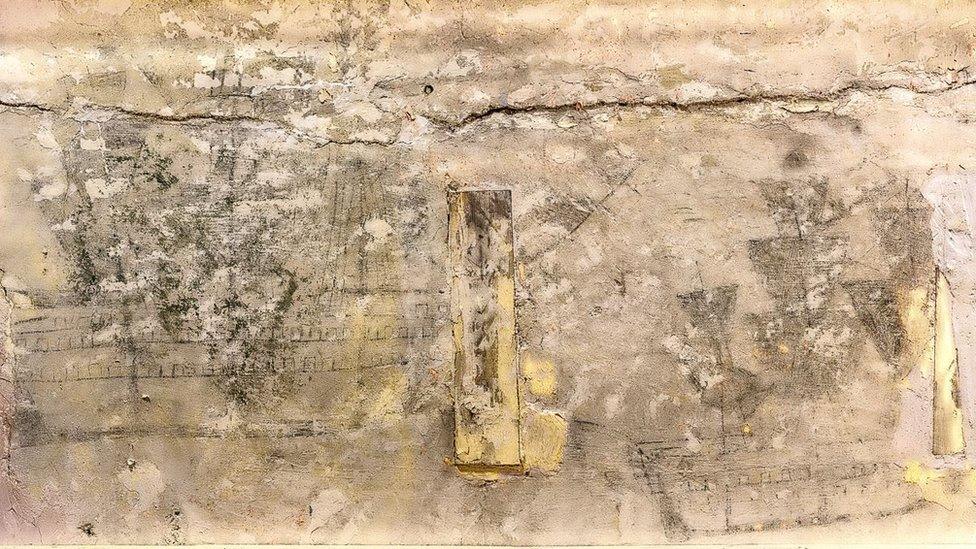Littleport's hunger riots: Descendants mark 200th anniversary
- Published

The story of the 1816 riots has been turned into a film, Riot in the Blood (above)
It resulted in five men being hanged on the scaffold and a mixed legacy of shame and pride. But what triggered a Cambridgeshire village to go on a three-day rampage soon after the end of the Napoleonic Wars?
The rioting broke out in Littleport on 22 May 1816, when about 100 people armed with pitchforks, cleavers and guns smashed windows and broke down doors, stealing money, food and goods from their wealthier neighbours.
Resident Elizabeth Little described Thomas South brandishing his cleaver and when she asked if he wanted bread or meat, he replied: "No, we want money". He demanded £1, but on being told Mrs Little only had 10 shillings, took that instead.

An inscription was put on the side of Littleport parish church, listing the men's names and crimes and ending, "May their awful fate be a warning to others"
Littleport's vicar tried to restore order by reading the Riot Act - the 1714 legislation had made it a crime for a crowd of 12 or more to refuse to disperse when ordered to do so by a magistrate.
Instead, the mob overwhelmed him, ransacked his house and he was forced to flee for Ely with his family.
The next day the rioters also set off for Ely, armed with a 8ft (2.4m)-long water-fowling firearm called a punt gun, which they had loaded on to a stolen wagon.
More than 300 people eventually participated in the riot, which was put down on 24 May by the Cambridgeshire Militia and the 1st (Royal) Regiment of Dragoons.
One rioter was killed, a soldier who had survived the Battle of Waterloo was maimed for life and 82 prisoners were committed to Ely Gaol.
On 28 June 1816, five men were hanged, "having been convicted of divers Robberies".
Death sentences were actually given to a total of 23 men and one woman, although the majority had their sentences commuted to transportation to Australia or imprisonment.

The rioters used a punt gun (as above), which carried nearly 1lb (450g) of gunpowder. It was designed to be used on a boat to kill many water fowl at once
The Littleport Riots were not isolated events, but part of "a wave of unrest" from 1815 onwards, according to Anglia Ruskin University historian Rohan McWilliam.
"There was economic dislocation after the end of the Napoleonic Wars and the introduction of the Corn Laws in 1815, which increased taxation on wheat," he said.
"Labour wages weren't keeping up with the cost of living, while poor harvests exacerbated the situation."
Previously common land, on which labourers could grow crops or keep livestock to supplement their wages, was being enclosed by landowners.
Their employment conditions had also changed, said University of Hertfordshire historian Katrina Navickas, to "daily hirings instead of yearly hirings - in essence, the introduction of a type of zero-hours contract".
This was exacerbated by a breakdown of the Poor Law, which was supposed to help the most vulnerable based on need with small sums of money and "in kind" goods such as shoes.

Elizabeth Little was a trial witness and described Thomas South brandishing a cleaver. The five hanged men were buried at St Mary's in Ely
Dr Navikas said: "Inflation is high after the Napoleonic Wars inflation and just the bare minimum is paid because ratepayers are saying they're paying too much."
And then to tighten the screw still further, the Game Laws passed in 1816 restricted the hunting of game to landowners, with transportation the penalty for poaching - or even being found in possession of a net at night.
The disturbance broke out when a group of mostly unemployed men met at the Globe Inn, for a meeting of the village Benefit Club.
Patricia Collins, whose ancestor William Beamiss was its treasurer and later hanged, said: "Members made contributions so they could draw out money when they were in need - but the problem was everyone was in need and the money had run out."
Feelings boiled over and the men left the pub and began intimidating their neighbours, fuelled by drink - and fury over the low wages, the high price of food and spiralling unemployment.

The riot began after a meeting at the long-since demolished Globe Inn
Research done by Cambridgeshire Archives suggests that vicar John Vachell was a particular target because "he was a local magistrate and well known for his harsh sentencing".
John Denniss feels proud to be descended from one of the executed men, but many of his forebears saw the story differently.
They "were ashamed" and even slightly changed the spelling of their surname from Dennis to Denniss, he said.
He believes his ancestor, the Globe's publican John Dennis, "was prepared to stand up for people worse off than him".
Miss Collins prefers to see contemporary parallels.
She said: "They were people driven to desperate straits and it's good to bring this story into the public eye at this time, when there are so many food banks."

John Denniss (right) is proud of his ancestor's role in the riots - pictured left are descendants meeting at the Co-op, where the Globe once stood
Jeremy Sallis is descended from Little Sallis, a trial witness who told the court he saw about 100 people, armed with weapons, smashing windows and looting in Littleport.
He was brought up believing his ancestor was a rioter, and only recently discovered "his evidence convicted people".
A spokeswoman for Cambridgeshire Archives said: "The government was genuinely worried by the danger of violent protest getting out of hand - the revolution in France was still fresh in everyone's mind and any challenge to the Establishment was seen to contain the seeds of revolution."
Justice was meted out by a government-appointed special commission, which set aside the Isle of Ely judge Edward Christian, the brother of Mutiny on the Bounty's Fletcher Christian.
A contemporary account described how on the scaffold, John Dennis, Isaac Harley, Thomas South, William Beamiss and George Crow "endeavoured to shake hands with each other, but having their arms pinioned they were prevented from so doing".
Miss Collins said: "John Dennis and William Beamiss were supposed to know better, because they were a publican and a shoemaker and were a bit older than the others - so they are supposed to have led them astray."

Soham rent collector John Aspland said "the poor about us have lately been very riotous" in a letter to landlord William Chatteris two days after the riot - to justify why he could not collect all he should
In Littleport, there is still a belief their rioters were "martyrs and made an example of", according to Deb Curtis from the Field Theatre Group, which has received a Heritage Lottery Fund grant to make a film, external about the disturbances.
Prof McWilliam does not agree - pointing to the execution of 19 men in the anti-mechanisation Captain Swing riots of 1830.
"Both the Littleport and Swing riots were protests at the increasing impoverishment of the rural poor and the government used the force of the scaffold to clamp down on unrest," he said.
"The rioters felt the full force of the Bloody Code, with 200 offences leading to execution."
He also points to the violence used to disperse unemployed Lancashire mill workers when they tried to march on Parliament in 1817 and the force used during Manchester's Peterloo Massacre of 1819. By 1820, there was even an attempt to overthrow the government in the Cato Street Conspiracy.

This graffiti is from the same era as the riots and was discovered when Ely's gaol building was being converted into a museum
After the executions, an inscription was put on the side of Littleport parish church, listing the men's names and crimes and ending, "May their awful fate be a warning to others."
The vicar, Mr Vachell, was one of many who sought compensation for the destruction of his property - and received £708, which is about £50,000 in today's values, external.
Littleport Parish also agreed to pay £5 a year to the Waterloo veteran whose arm was injured in the riot and later amputated.
Miss Collins said the men had tried to help themselves through periods of unemployment or sickness by paying into the Benefit Club.
"In today's terms, they weren't shirkers, they were workers who were looking after each other, but the need was so great the money had run out," she said.
And while former shop steward Mr Denniss knows there was a time when his family were ashamed about their connection to a man who joined - and possibly led - the mob - he believes his ancestor "fought for the underdog".